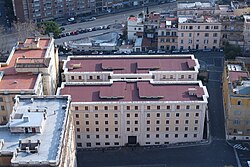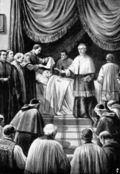Papal conclave

A papal conclave is a meeting of cardinals to elect the next bishop of Rome, to become pope. This becomes necessary when the old pope dies or resigns. Usually, popes do not resign, though. A two-thirds supermajority vote is required to elect the new pontiff.[1][2]
The last conclave was when Pope Francis died on April 21, 2025, and Pope Leo XIV was elected on May 8, 2025, to replace him.
Overview
The word conclave is from Latin. It refers to the fact that the cardinals are locked up together, until they have agreed on a new pope. Today, this happens in the Sistine Chapel.
Originally, the conclave was started in Italian city states, in the 12th century. These cities needed to elect officeholders, and the election needed to be free of party politics. Events such as the Investiture Controversy in medieval Europe led to people wanting "free" elections, with a medieval understanding of free. Methods were often combined, the elements used were Acclamation, naming of candidates by predecessors, or by uninvolved people, and using "electors" who would agree on the successor, behind closed doors. Earliest examples are that of Genua, in 1157, Pisa, in 1162-64, or Pistoia.
Pope Nicholas II published a papal bull called In Nomine Domini, in 1059, which introduced the conclave as the way to elect his successor.
Papal Conclave Media
The 1492 papal conclave was the first to be held in the Sistine Chapel.
Since the 2005 papal conclave, the cardinal electors reside in the Domus Sanctae Marthae for the length of the conclave.
The camerlengo proclaiming a papal death
Cardinals, bishops and priests attending the funeral of Pope John Paul II
Today, cardinal electors receive copies of multiple ballot cards, scrutiny ballots, and a copy of Ordo Rituum Conclavis (Order of Conclave Rites). Shown above are the ballot papers of Cardinal Roger Mahony used in the 2013 conclave.
Scrutiny during the conclave of 1903
White smoke in the Sistine Chapel, indicating that a pope has been elected by the College of Cardinals.
References
- ↑ Benedict XVI (11 June 2007). De aliquibus mutationibus in normis de electione Romani Pontificis Archived 22 December 2017 at the Wayback Machine (in Latin). Motu proprio. Vatican City: Vatican Publishing House.
- ↑ "Pope alters voting for successor" Archived 14 September 2007 at the Wayback Machine. BBC News. 26 June 2007.








